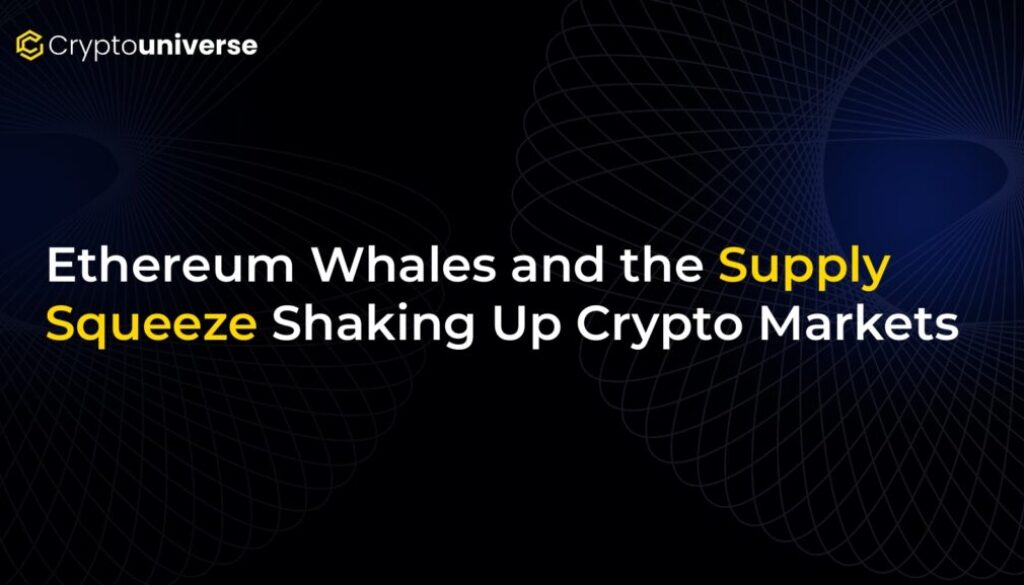Ethereum Whales and the Supply Squeeze Shaking Up Crypto Markets

The Unseen Giants: How Ethereum Whales Are Making Waves
Deep beneath the surface of the volatile crypto markets, a powerful current is forming. It’s not driven by fleeting trends or social media hype, but by the calculated moves of Ethereum’s largest holders—the so-called “whales.” These influential investors are quietly accumulating ETH at a staggering pace, setting the stage for a potential market-altering event: a massive supply squeeze. With their collective holdings swelling to nearly 30 million ETH, their actions are sending ripples across the entire digital asset ecosystem, and savvy investors are taking notice.
The recent market dynamics signal more than just accumulation; they point to a fundamental shift in strategy. The massive financial commitment by these key players suggests a deep-seated belief in Ethereum’s long-term value proposition, creating a scenario where the available supply of ETH on the open market could shrink dramatically.
A Tidal Wave of Capital: The Great Migration to Ethereum Staking
One of the most telling signs of this shift is the significant flow of capital into Ethereum. In recent weeks alone, market observers have tracked over $2.5 billion moving from Bitcoin into Ethereum staking contracts. This isn’t just portfolio rebalancing; it’s a strategic pivot that underscores a growing institutional appetite for ETH’s yield-bearing potential.
With the successful transition to a Proof-of-Stake consensus mechanism (The Merge), staking has become a core feature of the Ethereum network. By locking up their ETH to help secure the network, these whales are not only earning passive rewards but also removing vast quantities of tokens from circulation. Currently, nearly 30% of Ethereum’s total supply is staked, creating a powerful constraint that could provide significant price stability and pave the way for future growth.
Understanding the Ethereum
So, what happens when a third of a major asset’s supply is locked away? This is the essence of the supply squeeze shaking up the markets. Here’s a simple breakdown:
- Reduced Circulating Supply: As more ETH is committed to staking, the amount available for buying and selling on exchanges decreases.
- Increased Scarcity: Basic economics dictates that when supply dwindles and demand remains constant or increases, the asset’s value tends to rise.
- Heightened Buy Pressure: With less ETH to go around, new and existing investors must compete for a smaller pool of liquid tokens, which can drive prices up more rapidly.
This dynamic creates a feedback loop. As prices begin to climb due to scarcity, it can trigger a cascade of liquidations for those betting against the market. We’ve already seen this play out, with over $11 million in short positions being liquidated as Ethereum’s price surged, catching many bearish traders off guard.
More Than Just Staking: Ethereum’s Expanding Utility
While the staking narrative is compelling, it’s not the only factor underpinning Ethereum’s strength. The network is also the undisputed leader in asset tokenization—the process of creating digital representations of real-world assets on the blockchain. The market cap for tokenized assets on Ethereum has already surpassed an incredible $300 billion.
This explosive growth in tokenization provides a strong fundamental base for ETH’s value. It demonstrates the network’s versatility and its critical role in building the future of finance. As more institutions tokenize assets like real estate, securities, and commodities on Ethereum, the intrinsic demand for ETH (to pay for transaction fees, or “gas”) is poised for sustained, long-term growth.
A Double-Edged Sword for the Web3 Ecosystem
For Web3 startups and Decentralized Autonomous Organizations (DAOs), the actions of Ethereum whales present both immense opportunities and significant challenges.
The Opportunities:
- Capital Inflows: The rising price and institutional interest can attract more venture capital and talent into the ecosystem.
- Increased DeFi Participation: A bullish environment often encourages more users to explore and participate in decentralized finance (DeFi) protocols, boosting overall activity.
The Hurdles:
- Liquidity Constraints: While the supply squeeze is bullish for price, it can create challenges for projects that need to manage treasuries and convert crypto to fiat for operational expenses.
- Centralization Concerns: The concentration of staked ETH in the hands of a few large players raises valid questions about network decentralization and influence.
- Regulatory Scrutiny: The growth of staking and institutional involvement is attracting increased attention from regulators worldwide, creating an uncertain landscape that projects must navigate carefully.
The Path Forward: Navigating the New Ethereum Landscape
The rise of the Ethereum whales is fundamentally reshaping the crypto market. Their strategic shift towards long-term holding and staking is creating a powerful supply squeeze that could define the next chapter for the world’s leading smart contract platform.
While this trend signals strong confidence and presents a bullish outlook, it also introduces new complexities around liquidity, decentralization, and regulation. For investors and builders alike, understanding these dynamics is no longer optional—it’s essential for navigating the evolving world of digital assets. As the tides continue to shift, the Ethereum ecosystem stands on the brink of a transformative phase, driven by forces that could redefine financial paradigms for years to come.


